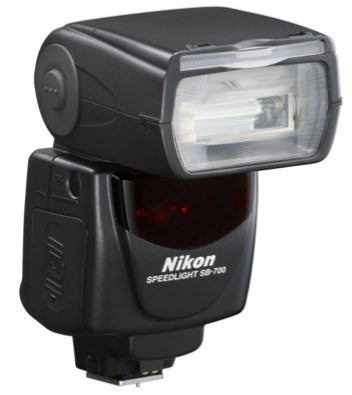Nikon’s strategy for designing and marketing its flash products is much the same as it and other photography equipment manufacturers use to market their cameras: Once they bring two or more products in the same line or series to the market, they create a niche with a new product that sits somewhere between the two existing products. This aptly describes the position of the Nikon SB-700 flash. It’s clearly an improvement on the much older SB-600, providing many types of digital photographers with plenty of features and a much friendlier interface.
The high end of this product line is the SB-900, which delivers considerable more light power than the SB-600, and even the SB-700. The SB-900 is the undisputed choice for pros that need its capabilities to ensure excellent quality for their clients; however, the newer SB-700 will do the job for all enthusiasts, hobbyists and most serious amateurs. All of them will be attracted to the SB-700’s compact size, dependability, upgraded features and the price, approximately $330.
Nikon made a smart decision when it designed the SB-700 to look like the SB-900, and with similarly easy manipulation of the controls. The SB-700’s additional buttons and control dial is far superior to fumbling through the SB-600’s menus and pressing multiple buttons to select a setting. Not only does the control dial include the on/off switch, but also selections for the remote and master modes and manual and TTL mode. The SB-700 kit is also more like the SB-900’s, with a carrying case, stand, diffuser dome, built-in bounce card and two filters. Whether shooting under incandescent or fluorescent light, the filters will equalize the SB-700’s output with these light sources.
The Nikon SB-700 comes with Through the Lens (TTL) technology that helps to fine-tune exposures. TTL also directs the flash to match the focal length when a zoom lens is used. With the wide-angle adapter, the SB-700 covers a greater range than 12mm. The Nikon SB-700 flash has many added features that immediately reveal its superiority to the SB-600.Auto-detects FX or DX camera.
- Master flash for other Nikon CLS flashes.
- Built-in temperature monitor to protect the bulb.
- Controls to select the flash mode, beam settings, remote/commander mode and zoom settings.
- Better weather sealing than the SB-900.
Many portrait photographers reportedly like the versatility of the Nikon SB-700. Using two of them, one as a main light and one as a fill light, provides all the needed light; and at a combined price that is considerably less than buying two SB-900s. The SB-700 has the power and dependability to work throughout a long portrait shoot without any recycling or overheating issues. A tip from one portrait photographer is to use lithium batteries for even faster recycling and more flashes per a set of four batteries.
Wedding photographers also find the SB-700 a very reliable light source, with plenty of power and more than adequate recycling time. They also appreciate its smaller size and weight. When deciding between the SB-700 and SB-900, photographers that shoot weddings exclusively should take into account that the SB-900 recycles faster and provides more batter life, especially because it can be connected to Nikon’s external battery, the SD-9, while the SB-700 cannot.
With the introduction of the SB-700 flash, Nikon has done the majority of photographers a great favor by providing them with all the flash they’ll ever need. For those photographers that think they may actually need the SB-900’s superior power and faster recycling time, it is easy to rent either or both to determine which best matches their type of photography, before making a purchase.
This article about "The Nikon SB-700 Flash" was first published on our website here https://www.photographytalk.com/photography-equipment-reviews/1571-digital-photography-equipment-reviewthe-nikon-sb-700-flash